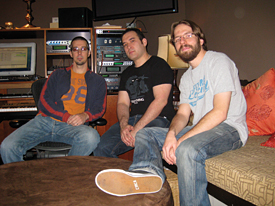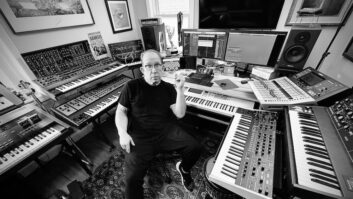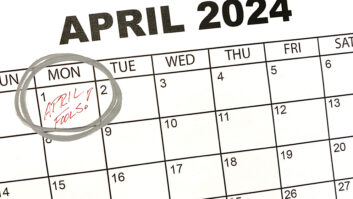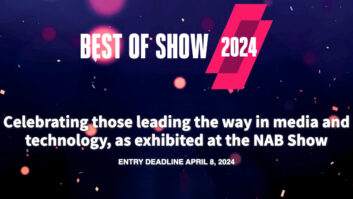
L-R: Dave Gold, Nate Morgan and Kenny Segal create original music at Elias Arts.
Elias Arts, the nearly 30-year-old company that creates original music for commercials, feature films and trailers, is a creative sandbox just a few blocks from the beach in Santa Monica. I’d heard they do things differently there, so I stopped by to check out the place.
Creative Director Dave Gold and composer/engineer Kenny Segal greet me in the lobby. As they lead me through the two-story maze of music and writing studios, offices, conference rooms and spaces for clients to use, I see cardboard boxes and cylinders scattered everywhere, as if they’d just moved in.
Gold chuckles when I ask what’s going on. “We’re currently working on a spot where everything takes place inside a cardboard box,” he explains. “But we’re trying to figure out what things sound like inside a box — what would music sound like if everything took place in a world inside a box? So we’ve been miking things in boxes, hitting boxes…”
“I spent half of yesterday trying to make a flute out of a cardboard tube,” says Segal.
Working in bursts of creativity that generally time out at 30 seconds or less, the company’s staff of eight composer/engineers (including three in their New York City facility — there’s quite a bit of creative interaction between the two coasts) created four spots for this year’s Super Bowl and worked with producer T Bone Burnett on a remix of The Who’s “My Generation” for Pepsi Pass that aired repeatedly during the Obama inauguration. Among recent longer-form projects: a series of artist profiles as part of Amnesty International’s “Music for Human Rights” campaign, with Coldplay’s Chris Martin as the first subject; and soundtracks for two upcoming films, Fighting and a remake of Children of the Corn.
“In our world,” says Gold, “we’re asked to do everything from techno to tango to hip-hop to rock, and to dabble in world music, so our guys have to constantly be flexing their creative muscles. Even though everybody’s working on their own tracks, the majority of our pieces end up being collaborative, so our studios are designed for speed, efficiency, compatibility, transferability — these things have become as important as the kind of gear that’s used.”
The studios are linked together and have identical setups: a Mackie Digital X Bus acts as a work surface and summing mixer for Digital Performer; an array of plug-ins and core sample libraries from EastWest, Native Instruments, Spectrasonics, Waves and Stillwell; a synth rack with a Roland 5080 and an E-mu Proteus; and at least one high-quality preamp from Vintech, Universal Audio, Studio Projects and/or Avalon. “The idea is to get a good, high-quality signal chain for a couple instruments at a time, and then do the rest of the work in the computer,” says Segal.
Gold explains the process: “Initially, we work up things in a demo state — quick, down and dirty ideas — but once the client starts leaning in a particular direction, we’ll often take a track that one of the guys has done, put it on the server, send it off to every single room, and everybody pulls it up and does their thing to it, because each of the guys has a different strength — they’re almost like a mini-band. We have one guy who’s a good guitarist; another guy, Nate Morgan, who’s a drummer but also has orchestral chops; and Kenny is really great at working from the computer out.”
“We have five or six people in the building, all working on a piece of music together,” says Segal. “That’s one of our strengths, and what sets us apart. The first round might be a competition, but once the client chooses a track, I might throw some hip-hop beats on there, then give it to someone else to do a couple of orchestral ideas, and by the time it gets finished, everybody’s touched it in some way. So we can not only deliver a huge orchestral score for you, but you can also call us at 7 on a Friday night and have six demos ready by Saturday afternoon, have it finalized by Sunday and ready to go to mix on Monday.”
Adds Gold, “These guys know if I’m walking around to all the studios at 3 o’clock on Friday afternoon, they know they’re probably gonna be spending a good part of the weekend here.”
Segal, who comes from the DJ/hip-hop/electronic world (he has his own indie imprint, Ken Can Cook), spent the morning compressing a 45-second, Bernard Hermann-style orchestral piece for the Audi Q5 to 13 seconds — a task he likens to solving a puzzle.
If all this sounds like a blast, that’s because it actually is, he says. “One of my favorite days ever was when we were working on a spot for Cisco Systems that called for an old-school techno track. Korg recently put out a piece of software for the Nintendo DS called the DS10 — it’s basically an emulation of a Korg synthesizer that has two mono oscillator synths, an analog drum machine and a little pattern sequencer. Dave had just bought a Nintendo for his kids, and I ended up doing the whole thing on it, then hooked the output into the Vintechs and recorded it into the computer. Unfortunately, they went with someone else’s 5080 dance track instead, but it was still a lot of fun.
“Working here,” Segal continues, “is almost like being a contestant on a show like Top Chef or Project Runway: Every day you have a new creative challenge given to you, generally a short time limit and several competitors.”
At Elias Arts, the fun often comes in tasty bite-sized pieces — 30 seconds or less — but you’ve gotta fight for your piece of the action and play nice with the other kids.
Send L.A. news to
[email protected].





